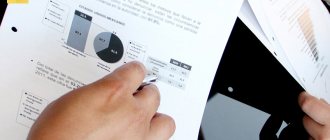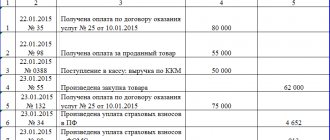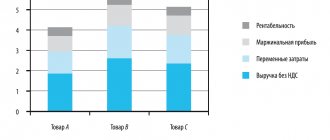In general terms, operating expenses are the costs of an enterprise that are not directly related to its core activities. The current edition of PBU 10/99 does not contain a precise definition of the terms operating income and expenses due to the change in classification according to Order No. 116n dated September 18, 2006. The legislation now proposes a simplified gradation for other expenses/income, as well as expenses/income for ordinary activities . How to determine what costs belong to what, how to calculate net operating income - we will explain in detail below.
What do operating expenses include?
All indirect expenses of the enterprise are recognized as operating expenses. Previously, there was a classification of costs into non-operating, operating and emergency. With the entry into force of Order 116n, such division was abolished, but it is possible if necessary at the request of the enterprise. A complete list of the main operating expenses is contained in paragraph 11 of Chapter III of PBU 10/99.
Operating expenses include the following costs:
- Representation of assets, including property, enterprises for temporary paid use or ownership.
- Submission for paid use of patent rights to intellectual property for various purposes.
- Participation in the authorized capital of other companies.
- Payment of cash settlements to credit institutions.
- Payment of interest on borrowed obligations of various types.
- Costs of disposal, sale, or other write-off of assets, property, goods, finished products of an enterprise, with the exception of Russian funds.
- Creation of valuation reserves by the enterprise, including for doubtful debts, for depreciation of securities, etc.
The listed types of costs are included in operating expenses if they do not relate to the main activities of the enterprise. Otherwise, such costs are subject to inclusion in ordinary expenses.
Analysis of efficiency and factors for increasing it
Optimizing operating costs is one of the main goals of enterprise management. Reducing them allows you to increase the speed of development of operational business activities, and therefore increase the amount of operating income. There are two types of factors that influence operating expenses - internal and external.
Internal factors are:
- Size of production and sale of finished goods. An increase in these parameters, although it will cause a jump in operating expenses, can also reduce the cost per unit of the product, because the volume of the constant component of this accounting item will not change. For example, in one building or room, several more coffee machines were added to the coffee machine already installed there. The costs of moving technicians servicing equipment have not changed, but the costs of required energy and consumables have increased. As a result, the total cost of one sold cup can be reduced due to the optimization of transport costs, which are now distributed among three machines, rather than one.
- Length of the production circle. With its decrease, the turnover time of current assets decreases, which means that the costs of maintaining products, losses from natural loss, collection costs for receivables, and unit costs for managing the organization are reduced.
- Marking the productivity of the process per individual employee. The higher this indicator, the lower the amount of expenses when paying employees.
- Technical safety of fixed assets necessary for work. The higher the level of wear and tear, the greater the cost of repair and maintenance.
- Number of personal current assets. The indicator is higher - financial costs for servicing borrowed funds are lower, and as a result, costs are lower.
External factors (not dependent on the wishes of the company) are:
- Inflation in the state. The higher its level in the country, the higher the expenditure indicator will be. This is due to the payment of wages, debt servicing, etc.
- Changes in tax rates or other mandatory payments. This is due to the fact that taxes occupy a fairly large part of operating expenses. Increasing the rate leads to an increase in their overall size.
What does operating income include?
Similar to expenses, operating income is classified as such if it is not related to the main work of the enterprise. Otherwise, they must be reflected in account 90 and accounted for as revenue from ordinary activities. A complete list of types of income from other operations is contained in paragraph 7 of PBU 9/99.
Operating income consists of income:
- From paid representation to time-limited use of enterprise assets.
- From paid representation of patent rights to various types of intellectual property.
- In connection with participation in the authorized capitals of other companies, including interest and income from investments in bonds and securities.
- From participation in simple partnership agreements.
- From the sale of property, assets of the organization, goods or manufactured products.
- Interest received on loans and borrowings.
- Accrued penalties for violation of contractual terms.
- From assets received free of charge.
- Profit of previous periods.
- Compensation for losses caused to the enterprise.
- Amounts of accrued exchange rate differences.
- Amounts of accounts payable that have already expired.
- Amounts of recognized income from revaluation of assets.
- Other types.
Differences from capital expenditures
Capital and operating costs are the two main types of expenses used in an enterprise's cash flow cycle.
These expenses are completely different from each other, starting with the method of their acceptance in both accounting documentation and tax accounting. It has already been described above that operating expenses are a type of other expenses when funds are not involved in the main activities of the organization. Capital costs are the amounts spent by the company on the purchase of non-current assets, as well as on their modification (extension, restoration, etc.) or modernization.
The main characteristic of capital expenditures is the duration of their work. When a company intends to invest in assets for more than a year, the operation is likely to be classified as capital expenditure (CAPEX).
However, what exactly will be considered waste of funds depends greatly on the type of work and the rules used in the industry. For example, one organization will include the purchase of a new printer to replace a broken one as capital expenditures, another will include the purchase of a license, and a third will include the receipt of a new building or office as CAPEX. In reality, investments in fixed assets and intangible assets are most often attributed to such expenses.
Net Operating Income - Formula
As can be seen from the contents of the lists, income and expenses practically coincide in their economic purpose. In this regard, the ratio of operating expenses to operating income is used when calculating profit for other facts of business activity. Separate accounting allows you to determine net operating income:
Net operating income is: The amount of VA (the actual amount of gross income) – the amount of OP (operating expenses excluding depreciation).
The indicator characterizes the amount of net profit from the use of property, contributions to the authorized capital, investments in securities, and other types of income. It is economically important to calculate the NIR for the current period. But a one-time positive result is not a guarantee of profit in future periods.
The ratio of operating expenses to the company's sales revenue will help to calculate the operating expense ratio, which characterizes the dynamics of the profitability of overall activities. The lower the value obtained, the more profit the company has for the reporting period. The higher the coefficient, the more significant the business costs to maintain its livelihoods.
KOR (OER) = OR / Total income
An enterprise can establish formulas for calculating operating income and operating expenses independently, adhering to the legislative norms of PBU 9/99 and 10/99. It is recommended to measure performance indicators on the basis of financial (accounting) reporting data. Calculations are made for a period - month/quarter or for the reporting year.
How to take measurements
Information collection method
The data for the key performance indicator (KPI) in question is taken from financial statements and accounting systems.
Formula
OER = (Operating expenses for period t / Sales revenue for period t) × 100%.
The numerator is the sum of all operating expenses.
This indicator is calculated monthly or quarterly.
The data for the KPI in question is taken directly from the income statement, where operating expenses are summarized over a certain period of time - a month or a year.
If information on operating costs is readily available, then the cost of measuring the indicator is relatively low. Otherwise, with the manual method of calculating operating expenses, costs increase significantly.
Target values
The target value of the indicator depends on the industry in which the company operates. In industries with high R&D costs, such as the pharmaceutical industry, operating costs are traditionally higher.
Example. Let's look at an example of calculating the operating expense ratio.
First of all, we must calculate the amount of operating expenses by determining all the costs of conducting the company's operating activities. Administrative expenses and salaries, equipment maintenance costs, travel expenses, marketing and insurance costs, and other overhead costs for leasing buildings and equipment are all operating expenses. Operating expenses for a given period can be taken directly from the income statement, which includes all expenses associated with running the company's day-to-day operations (excluding capital expenditures).
If a company has the following cost structure: R&D - $1,000, sales and marketing - $4,000, administrative expenses - $2,000, lease payments - $500, depreciation and amortization - $150 for a given period, and sales revenue - $40,000, then the calculations will be as follows:
OPEX = 1000 + 4000 + 2000 + 500 + 150 = $7650
OER = (7650 / 40,000) × 100% = 19.13%.
Notes
Remember that OER is only useful as a comparative indicator for companies in the same industry.
Also keep in mind that large expenditures (such as a large research and development project) occurring during the period for which OER is being calculated and not likely to generate revenue in the coming years may skew the OER and operating expense ratio.
Every manager is interested in ensuring that his project is effective at all phases of its development. Therefore, to manage expenses, a special classification was created, which divides them into separate groups and helps to generate a profit and loss statement for the enterprise.
Operating expenses of an enterprise are expenses of an organization that are not directly related to its main activities. For example, purchasing a printer for an office is a capital expense, while purchasing paper, refilling cartridges, and maintaining it will be an operating expense.
Controlling company costs
Until 2006, enterprise costs were divided into two groups:
- Direct - cost items associated with the main activities of the enterprise and included in the cost of production.
- Indirect – related to maintaining the life of the company and not included in the cost of the final product or service.
Indirect, in turn, were also divided into three types:
- Non-operating – related to the acquisition of fixed assets.
- Operational – aimed at the functioning of the enterprise.
- Emergencies – caused by unforeseen emergency situations.
Composition of expenses
Operating expenses are the opposite of capital expenses and the direct costs of making goods.
Operating expenses include costs that are aimed at:
- Formation of reserves;
- Payment of bank commissions;
- Participation in the capital of other companies;
- Providing rental use of your assets;
- Sales or write-off of goods for other reasons;
- Granting temporary use of copyrights.
Accounting for operating and non-operating income and expenses [p.519] In financial accounting, operating and non-operating income and expenses are reflected in synthetic account 91 Other income and expenses.
In this case, income received is taken into account in the credit of account 91, and expenses are taken into account in the debit of this account. [p.85] Since 2007, organizations no longer need to keep separate records of operating and non-operating income and expenses on account 91, that is, open second-level subaccounts for them. Extraordinary income and expenses should not be reflected in account 99 either. [p.460]
The Ministry of Finance of the Russian Federation has done some work in this direction. As of January 1, 2002, fifteen accounting regulations (standards) have been developed. Starting from the annual report for 1995, the most important indicators for assessing the financial and economic activities of an organization - sales of products (works, services), cost, financial results could be formed based on the accrual principle. Since January 1, 2002, this method has become decisive. With the introduction of the new Chart of Accounts, adaptation to international practice was carried out in the existing methodology for accounting for the formation of financial results from sales of products, work performed and services provided, as well as from other operations that generate operating and non-operating income and expenses. However, this accrual principle has not been implemented comprehensively. As already noted, small business organizations, when choosing an accounting policy for generating sales revenue for accounting purposes, have the right to deviate from the generally accepted shipping principle, which is currently mandatory for other organizations. [p.448]
When calculating individual components of gross profit - the financial result from sales, as well as operating and non-operating income and expenses - there are many other nuances determined by the types of activities carried out by the accounting entity, its organizational and legal form and other characteristic points. [p.572]
The composition of operating and non-operating income and expenses is given in the Accounting Regulations Organizational Income PBU 9/99 and the Accounting Regulations Organization Expenses PBU 10/99. [p.43]
Other operating and non-operating income and expenses in accounting are reflected in account 91 “Other income and expenses”. The balanced result of this account in the form of profit and loss is written off monthly, like the balance of account 90 “Sales”, to the final savings account of financial results 99 “Profits and losses”; the balance in the form of profit is to the credit of account 99 from the debit of account 91, and the balance in in the form of losses - to the debit of account 99 from the credit of account 91. [p.283]
Accounting for financial results involves determining profits or losses from operations on the sale of goods or finished products, on the disposal of fixed assets or other property, the ratio of operating and non-operating income and expenses of the organization, and the calculation of income tax. Account 90 Sales is used to compare income and expenses for sales of goods and finished products. The credit of this account reflects the amount of revenue with value added tax, the debit - the amount of VAT accrued at the time of sale, the cost of finished products and sales expenses (advertising expenses, packaging costs, marketing research) [p.611]
In financial accounting, balance sheet profit is formed on account 99, which takes into account, in addition to profit from core activities, non-operating income and expenses, profit (losses) from other operations. In this simplified example, the enterprise did not carry out any other types of activities other than the main one, and the enterprise did not have operating or non-operating income (expenses). Therefore, the profit of financial accounting coincides with the profit calculated in the management accounting system (705 rubles). [p.345]
It should be noted that the division of income and expenses into non-operating and operating plays a role only when preparing reports in the currently recommended formats. As for the formation of the financial result, the given differentiation is not significant, since both income (expenses) are taken into account in the accounting system on the same account 91 Other income and expenses. [p.188]
Expenses are recognized in accounting regardless of the intention to receive revenue, operating or non-operating income and the form of the expense (cash, in kind or otherwise). This principle of recognition suggests that, as a rule, an organization carries out all major expenses with the aim of generating income, but according to the requirement of completeness, all expenses are recognized in accounting, regardless of the intention of their implementation. [p.401]
The correctness of attributing costs paid directly from the current account to the cost of products (works, services), to accounts for non-operating income and expenses, other operating income and expenses for accounting and taxation purposes. [p.160]
Accounting for other income and expenses (operating and non-operating) of the reporting period, except for extraordinary income and expenses, is kept in account 91 Other income and expenses in subaccounts 1 Other income, 2 Other expenses, 9 Balance of other income and expenses. [p.543]
According to the Accounting Regulations Accounting statements of an organization (PBU 4/99), the profit and loss statement must characterize the financial results of the organization for the reporting period. In the profit and loss statement, income and expenses must be shown divided into ordinary, operating, non-operating and extraordinary (PBU 9/99 and PBU 10/99). An example of a report is presented in Appendix 10. [p.25]
Considering periodic expenses as expenses associated with the functioning of the entire organization and taking into account that the financial result of the organization’s activities consists of the result identified on account 90 Sales, as well as operating income and expenses and non-operating income and expenses accounted for on account 91 Other income and expenses, we should, in our opinion, classify general business expenses as operating expenses and provide for their write-off at the end of the reporting period to the accounts of other income and expenses. [p.102]
Analytical accounting for account 91 Other income and expenses is maintained for each type of operating and non-operating income and expenses. [p.392]
With the transition to the new Chart of Accounts, such expenses are attributed by decision of the organization in accordance with the provisions of PBU 10/99 to expenses associated with the production and sale of products (works, services) (reflected in cost accounts, and subsequently in account 90 Sales), operating and non-sales (recorded in account 91 Other income and expenses, subaccount Other expenses) or directly to extraordinary expenses of the organization (directly account 99 Profits and losses) without reducing the taxable base for income tax. [p.30]
The sections Operating income and expenses and Non-operating income and expenses reflect income and expenses recognized by the organization in accounting as other in accordance with the conditions defined for their recognition in the Accounting Regulations Organizational Income PBU 9/99 and the Accounting Regulations Organization Expenses PBU 10/99, and in the amount in accordance with the requirements of these provisions. [p.359]
Account 91 Other income and expenses is used to obtain data on other income and expenses other than ordinary activities, except for extraordinary income and expenses. In accounting, such income and expenses are considered as operating (from the sale of fixed assets, etc.) and non-operating (fines, penalties, penalties for violation of contract terms, etc.). [p.220]
The concept of profit (loss) from ordinary activities is interpreted quite unexpectedly. Instead of, as might be expected, defining ordinary income (loss) as the difference between income and expenses from ordinary activities, these indicators are calculated taking into account operating and non-operating income and expenses. [p.639]
Other operating income, Other operating expenses. These items reflect, respectively, income and expenses on operations related to the movement of property of the enterprise, the disposal of which is recorded in the accounts of the accounting account 47 Sales and other disposal of fixed assets and 48 Sales of other assets, as well as parts of non-operating income and expenses recorded directly in the account 80 (except for income and expenses given under the items Interest receivable, Interest payable, Other non-operating income and Other non-operating expenses). In this case, for all operations separately (expanded) income is shown on line 090 and expense on line 100. [p.423]
An original innovation in the use of accounts 90 Sales, 91 Other income and expenses and 99 Profit and loss will be the making of entries in the sub-accounts opened for them cumulatively during the reporting year (accounts are not closed monthly, as was done in the previous sales accounting accounts). The determined financial result (profit or loss) from sales/operating and non-operating income and expenses for the reporting month from the separate sub-account intended for their determination is written off monthly to account 99 Profit and loss. At the same time, in general, there is no balance on accounts 90 and 91 at the reporting date. The construction of these accounts allows you to generate the necessary information for the preparation of financial statements directly without the use of accumulative statements, as was established earlier. [p.165]
The composition of income and expenses from ordinary activities, operating, non-operating, as well as extraordinary income and expenses is presented in the table. Let's consider the reflection of income and expenses in accounting accounts. [p.330]
At manufacturing enterprises, accounting for other income and expenses is kept on account 91 “Other income and expenses”. This account records both operating and non-operating income and expenses. [p.285]
This classification of income and expenses into non-operating and operating plays a significant role only when preparing financial statements. Such differentiation of income and expenses does not matter when calculating the final financial results of the enterprise. Therefore, in accounting, these income and expenses are taken into account in accounting account 91 “Other income and expenses”. [p.47]
The concepts of income and expense in accounting and tax accounting are different. In accounting, income is divided into income from core activities, operating, non-operating and extraordinary expenses - into expenses for core activities, operating, non-operating and extraordinary expenses. [p.547]
Line 050 reflects the profit (loss) from the main sale, line PO shows the profit or loss from the main sale and the balance of other operating income and expenses, which are shown in detail in Form No. 2. The amount of profit or loss from core activities and the balance of operating expenses form profit (loss) from financial and economic activities, reflected in the software line. Taking into account non-operating income and expenses, profit (loss) for the reporting period is formed (line 140). After deducting income tax from the profit (loss) of the reporting period and other diversions from profit, what remains is undistributed profit (uncovered loss) of the reporting period (line 170 f. No. 2) or net profit, which is shown in the balance sheet on line 480. [p. 353]
Secondly, since PBU 9/99 and 10/99 establishes the division of all income and expenses into operating and non-operating, then, in our opinion, to account for these income and expenses, two separate accounts should be provided, and not one. For this reason, in practice, business entities in the working chart of accounts provide [p.85]
Due to the fact that the new Chart of Accounts provides for accounting for other income and expenses only one account for the formation of such important indicators of the organization’s activities as operating profits/losses and non-operating profits/losses, the following three sub-accounts must be opened for account 91 [p.86 ]
For accounting purposes. Profit for accounting purposes is determined as follows. First, gross profit is calculated (the difference between income and expenses for the normal activities of the enterprise), then profit (loss) from sales is determined (commercial and administrative expenses are subtracted from gross profit). Next, profit (loss) before tax is calculated by deducting the balance of operating and non-operating income and expenses from sales profit (Table 9). [p.64]
The section provides a breakdown of individual income and expenses from the category other operating income (expenses) and other non-operating income (expenses), which were received (identified) by the organization for the reporting and previous year and included in the corresponding items of the profit and loss statement. The list of indicators can be expanded taking into account rights and materiality. [p.798]
Starting from the reporting for 2006, other expenses and income ceased to be divided into operating and non-operating, therefore the following accounting provisions were changed [p.4]
The sections Operating income and expenses and Non-operating income and expenses reflect income and expenses recognized in accounting as other in accordance with PBU 9/99 and PBU 10/99. [p.26]
Unlike PBU, in the Instructions for the Application of the Chart of Accounts, operating and non-operating income and expenses are not distinguished as part of income and expenses reflected in account 91 Other income and expenses. [p.382]
The composition of operating income and expenses is regulated by PBU 9/99 Income of the organization and PBU 10/99 Expenses of the organization. Accounting for operating income and expenses is carried out in subaccounts 91-1 Other income, 91-2 Other expenses; in some cases (for example, when reflecting the gratuitous receipt of material assets), account 99 Profits and losses is used. Every month, the difference between the amount of income and expenses reflected in subaccounts 91-1 and 91-2 is reflected in subaccount 91-9. It should be taken into account that subaccounts 91-1 and 91-2, in addition to operating income and expenses, may reflect non-operating income and non-operating expenses. [p.398]
The model of production, economic and financial activities is aimed at describing the facts of economic life reflected by book accounting. When describing this model, it is advisable to use the classification of income into income from ordinary (main) types of activities (revenue - B) operating - OD non-operating - IRR extraordinary - CRD. Accordingly, expenses are divided into expenses of ordinary (main) types of activities - operational departments of internal affairs - non-operating OR - emergency VnR - ChR. [p.373]
In accounting, expenses are recognized regardless of the intention to receive revenue, operating, non-operating or extraordinary income and in the reporting period in which they occurred, regardless of the time of actual payment of funds, which corresponds to the principle of temporal certainty of the facts of economic activity. [p.41]
Please note that by order of the Ministry of Finance of Russia dated March 30, 2001 No. 27n On introducing amendments and additions to regulatory legal acts on accounting, clause 8 of the Accounting Regulations Organizational Income [12] and clause 12 of the Accounting Regulations Organization Expenses were changed [13]. In accordance with the new edition, non-operating income is: .. the amount of revaluation of assets - non-operating expenses are. .. amount of asset depreciation . Let us recall that the previously effective rules did not apply to non-current assets; non-operating income (expenses) included the amount of revaluation (depreciation) of assets, but with the exception of non-current assets. It should be noted that the list of operating income given in paragraph 7 of PBU 9/99 [12] (as amended by Order of the Ministry of Finance of Russia dated March 30, 2001 No. 27n) is closed. Consequently, the norm of paragraph 7 of PBU 9/99 [12] does not allow income arising as a result of revaluation to be classified as operating income. [p.97]
If we are completely consistent in applying the concept of dividing expenses into production and periodic, then it seems reasonable and logical to us to consider general business expenses, if they are recognized as periodic, as one of the types of operating expenses and, as a consequence, write them off at the end of the reporting period directly to account for other income and expenses. The logic of this approach is also due to the fact that usually the financial result of an organization’s activities does not consist only of the result identified in account 46 Sales of products (works, services) (90 Sales) as a result of ordinary activities. There are operating income and income from non-operating operations, etc. Periodic expenses represent the costs associated with the existence of the entire organization, no matter what activities the organization carries out and no matter what income it receives (see the author’s draft Regulations on Accounting Expenses of the Organization in Appendix 5 of this publication). [p.412]
The organization's accounting policy involves calculating costs using the direct cost method, which allows one to generate better information about the organization's expenses and profits. Indicators of the dynamics of expenses allow us to conclude that their growth is excessive, exceeding the growth of revenue and other income. Thus, if revenue increased during the analyzed period by 9.3%, and total income (including revenue, operating and non-operating income) by 31.3%, then the increase in expenses for ordinary activities amounted to 15.2%, and total expenses (without income tax accounting) increased by 41.6%. This ratio of growth rates led to a decrease in financial results not only for core activities by 16.7%, but also in total financial results (profit before tax) by 33.3%. In the increase in expenses, the predominant share of operating expenses is 73.0%, the share of expenses for ordinary activities is 29.8%. The structure of expenses by area of activity is dominated by expenses for core activities, the second largest component is operating expenses. At the same time, over time, the share of operating expenses increases from 19.8 to 34.2%, which requires additional study based on accounting data. In the structure of expenses, financial expenses are insignificant, although, as the previous analysis showed, the organization has a fairly significant amount of external borrowed sources. The explanation for this is the fact that the organization attracts capital at rates that are below market rates, which allows it to minimize financial costs. [p.419]
The argument for distribution within the reporting period is based on the uselessness of reported data on net income without taking into account extraordinary items. There is an opinion that the operating net profit indicator is more useful to investors in analyzing and forecasting profits. Without distribution, i.e. Without a distinction between operating profit and non-operating profit, the frequent profit indicator may be misinterpreted. If expenses and income from core activities remain constant over a number of years, and non-operating profits or losses are irregular, then [p.456]
The procedure for classifying expenses in accounting is similar to the procedure for classifying income. They are divided into expenses for ordinary activities and other expenses (PBU 10/99, clause 4). Other expenses, in turn, consist of operating, non-operating and emergency expenses. [p.29]
The object of income tax is taxable profit, or profit for tax purposes. Taxable profit is calculated on the basis of accounting and reporting data, the basis for calculation is the gross profit of the organization for the taxable period. Gross (balance sheet) profit is calculated in accounting as the amount of profit (loss) from the sale of products (work, services), fixed assets (including land), other property of the organization, as well as other income reduced by yMjviy other expenses. Other income and expenses include operating, non-operating and extraordinary income and expenses. [p.656]
The sections Operating income and expenses and Non-operating income and expenses reflect income and expenses recognized by the organization in accounting as other in accordance with the conditions. Under the article Interest receivable in the Operating income and expenses section, operating income is reflected in the amount of interest due in accordance with agreements on bonds, deposits, government securities and others, for the provision of funds to the organization for use, for the use of funds in the account by the credit organization organizations in this credit institution. [p.38]
Postings in accounting
So, accounting for income tax income is the identification of amounts for the past period that may affect the size of the tax base up or down.
To understand how accounting occurs, you can consider the following example:
According to the court decision to recover compensation from the purchaser of products for which he did not pay, the applicant organization received it, while the court decided to collect from the defendant the amount of state duty in the amount of 4,300 rubles.
After which the company accountant made the entries indicated in the table.
| Account correspondence | Sum | Definition | |
| Debit | Credit | ||
| 68 | 51 | 4,300 rubles | Payment of the state fee for filing a claim |
| 91, 91.2 | 68 | 4,300 rubles | Accounting for state duty in non-sales amounts at the time of consideration of the claim |
| After the court decision comes into force | |||
| 76 | 91, 91.1 | 4,300 rubles | Instruction for the defendant's debt regarding the payment of state fees for legal costs |
| 51 | 76 | 4,300 rubles | Indication of receipts from the defendant |
In addition, entries regarding other income may be of a different nature.
| Postings | Explanation |
| Dt 76, 62 Kt 91 | Accrual of income from OS rental |
| Dt 50, 51 Kt 76 | Receipt from the tenant |
| Dt 01.09, Tt 01.01 | Write-off of a fixed asset from the balance sheet when it is sold after 5 years of operation |
| Dt 91.09, 01 Kt 91, 99 | Receiving funds from the buyer of a written-off OS |
| Dt 76.05, Kt 91.01 | Accrual of penalties for broken agreements |
| Dt 60, 76, Kt 91 | Write-off of bad debts |
| Dt 62, 60 Kt 91 | Calculation of the difference at the rate |
In the process of determining the amount of income, accounting and tax accounting have practically no differences; they exist only with a few exceptions:
- In the process of selling fixed assets with a difference in depreciation, the amount for which is allocated monthly
- Sale of operating systems with different initial costs, for example, during leasing
- In the process of occurrence of differences in amounts arising only in tax accounting







